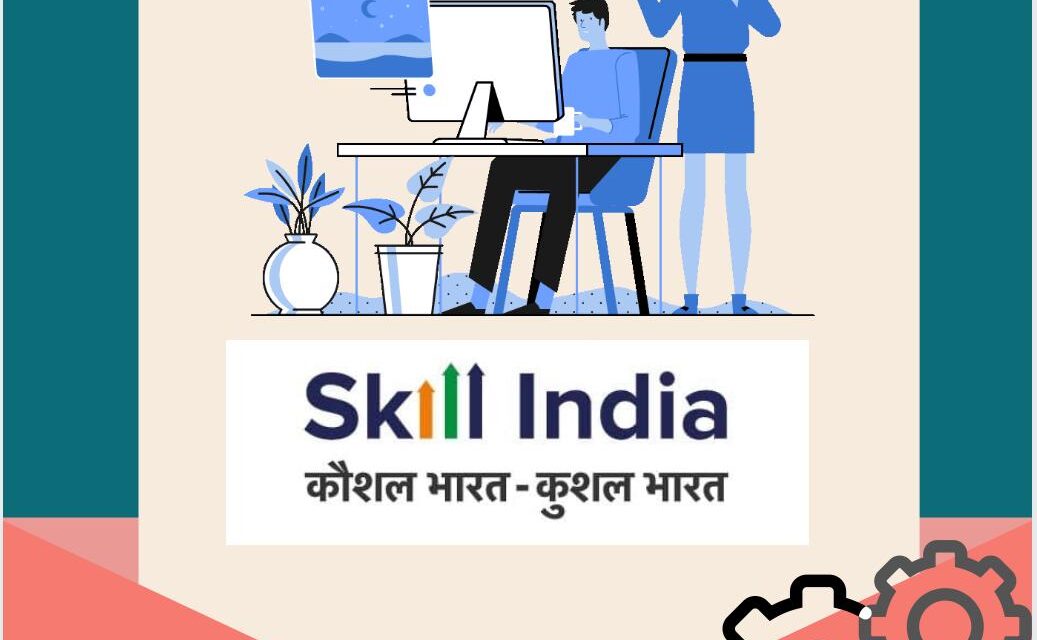Skill India Mission and the potential impact of its implementation


Aditi Agarwal
UNDERSTANDING THE POLICY
Atmanirbhar Bharat, which means ‘self-reliant India’, is at the heart of the current government’s mission and efforts for economic development in India. The term has been used with regards to making India “an integrated and more important part of the global economy“. It is with this main approach that the government has launched various schemes and missions which will form the base for a self-sufficient India. One such crucial mission is the Skill India Mission, which focuses on Human Resource Development, the most important aspect of Atmanirbhar Bharat.
The Skill India Mission initiative was launched in the year 2015 to train over 40 crores young and middle-aged Indians in tertiary and industrial sector-related skills, with the vision to create an empowered workforce, ready to be self-reliant by the year 2022. Most importantly, the Mission aims to close the gap between skills required by the industry and skills people possess for employment generation. In the long run, the policy will help in reducing poverty in the country, it will increase the competitiveness of Indian businesses, ensure that skill training imparted is relevant and of quality, prepare Indians to take on the world’s manpower market, diversify the existing skill development programs to meet today’s challenges, build actual competencies rather than giving people mere qualifications, augment better and active engagement of social partners and build a strong public-private partnership in skill development. It will also mobilize adequate investments for financing skills development.
To fulfill these goals, in the past 5 years the Ministry of Skill Development and Entrepreneurship has launched an umbrella of flagship programmes and successful schemes such as the Pradhan Mantri Kaushal Vikas Yojana (PMKVY), Skills Acquisition and Knowledge Awareness for Livelihood Promotion (SANKALP), Standard Training and Reward (STAR), PM-YUVA, etc.
All of this is set in a context of shifting skills and an increasingly digital environment. In a post-COVID world, renewing workers’ skills is a tactical necessity, but reskilling is not a sufficient path forward by itself. The skill shortage is too vast. The pace of change is too rapid, quickly rendering even “successful” reskilling efforts obsolete. What is needed is a worker development approach that considers both the dynamic nature of jobs and the equally dynamic potential of people to reinvent themselves. To do this effectively, the initiative focuses on building workers’ resilience for both the short and the long term—a focus that can allow organizations to increase their reach to further enhance intending resilience in the face of constant change.
POLICY FORMULATION: NEED FOR SKILL INDIA
According to the Human Development Report (HDR) 2020 released by the United Nations Development Programme (UNDP) in December 2020, barely one in five Indians in the labor force is ‘skilled’. Based on data gathered by the International Labor Organisation, UNDP in its HDR report 2020 mentioned that out of the total, only 21.2% of India’s labor force is skilled.
As a result, there is a huge problem of employability among the educated workforce of the country. Lack of vocational or professional skills makes it difficult for the youth to adapt to changing demands and technologies of the marketplace. The high level of unemployment is due to the failure to get jobs and also due to a lack of competency and training. A study by the National Skill Development Council (NSDC) indicates that there will be a need for around 12 crores of skilled manpower by 2022 across 24 key sectors. Casual workers, who constitute about 90% of the labor force, are poorly skilled as they do not get adequate training.
MSMEs are a source of employment, innovation, and entrepreneurial skills and have a large industrial output. Working with constrained resources- low in capital and technology requirement and using the most readily available inherently skilled or unskilled workers, MSMEs in India account for more than 80% of the total number of industrial enterprises and produce over 8000 value-added products. They provide the largest share of employment after agriculture in the country, with 45% of output in the industrial sector coming from MSMEs. However, despite its huge contribution, the sector faces challenges in accessing a skilled workforce – most work is done by unskilled persons and finds no capital or incentive to invest in skill development.
Most major economies of the world have an aging population. India, on the other hand, is currently moving through a favorable demographic dividend, as the proportion of working-age groups of 15-59 years will be increasing steadily in the upcoming years. Harnessing the demographic dividend through appropriate skill development efforts would provide an opportunity to achieve inclusion and productivity within the country and also a reduction in the global skill shortage. As productivity improves in agriculture due to increased mechanization, there will be fewer people required in the farming sector. There will thus be a shift from this sector to other secondary and tertiary activities. Large-scale skill development is, therefore, an imminent imperative.
POLICY IMPLEMENTATION
In its 11th five-year plan for the financial year 2007-12, the then Government of India suggested actions to increase the skilled workforce in the country to 15 million annually and targeted to skill 500 million people by 2022. In line with this, the government formulated a skill development policy in 2009, with emphasis given to special courses to be imparted through Industrial Training Institutes in partnership with the private sector.
In the 12th five-year plan, a further push was given to skill development and employment. The new government at the center in 2014 created a dedicated Ministry of Skill Development and Entrepreneurship to look after various activities of skill development. The Ministry has successfully constructed 25000 training centers that offer more than 3000 skill-based courses across 37 sectors. Since 2014, almost every year approximately 1.5 crore young Indians join the Skill India Mission. The ministry has introduced various schemes and programmes to achieve the mission, the most prominent of which is the Pradhan Mantri Kaushal Vikas Yojana (PMKVY). Under PMKVY, more than 250 short-term courses have been launched that give all sections of society free training in digital and soft skills, with a special emphasis on entrepreneurship. This scheme has benefited 16,64,760 people as of December 2020.
Similarly, the Recognition to Prior Learning Initiative converts the informal sector to the formal sector. In 2016, as part of the Mission, the government had launched the National Apprenticeship Promotion Scheme. In this year’s budget, the Government proposed to amend the Apprenticeship Act with a view to further enhancing apprenticeship opportunities for our youth. The existing scheme of the National Apprenticeship Training Scheme (NATS) was realigned for providing post-education apprenticeship, training of graduates and diploma holders in Engineering. Over 3,000 crores will be provided for this. To boost employment in rural areas, more than 247 centers were established under the Jan Shikshan Sansthan which benefitted 4.15 lakh people, out of which 85% were women trainees. In partnership with IIM Bangalore, the government has set up Mahatma Gandhi National Fellowship, with the aim to provide academic exposure in the management sector to the rural youth.
The government is partnering with the United Arab Emirates (UAE), to benchmark skill qualifications, assessment, and certification, accompanied by the deployment of a certified workforce. The government of India also has a collaborative Training Inter Training Programme (TITP) between India and Japan to facilitate the transfer of Japanese industrial and vocational skills, techniques, and knowledge.
In the past 5 years, India has reached the 13th rank in the World Skills competition from its original 29th position.
POLICY EVALUATION: CONCLUSION
According to the report by National Skill Development Council 2020, Skill India Mission with its various schemes and programs has ensured training capacity in 29 States & 4 UTs through the NSDC Partner Ecosystem; 560 districts have at least one NSDC Partner center (avg. is 7 centers/ district); 40 Sector Skill Councils have been formed consisting of over 450 representatives from Industry associations, Government and Academia – supporting employers to take lead in mapping Competency requirements and most importantly, the mission has developed competent standards for job roles across sectors – 1700 Qualification Packs and 4314 National Occupation Standards (NOS) have been created.
However, it must be noted that the picture is not as good as the numbers paint it to be. Because the country started its skill development at a very late stage, and its substantially recent, the statistics showing growth are exemplary but it needs to be taken into account that a large majority of the labor force remains unskilled and unemployed in the formal sector.
The Skill India Mission faces numerous challenges. Many current vocational training programs do not meet their demands. There is a problem of social acceptability when it comes to vocational education. Vocational courses are looked down upon and this needs to change. Another factor that acts as an obstacle to skill development in India is the myriad labor laws. The government has however started simplifying and codifying the labor laws. With simpler laws, practicing skill development should be easier. Changing technology is a big challenge and opportunity for the labor force. Employees will have to constantly upgrade their skills if they are to remain relevant in the job market. There is also a severe lack of infrastructure in the current training institutes. Another problem is the poor quality of trainers available. Students trained by such trainers are not competent enough to be employable in the industry. There is a huge issue with the standardization of skills in the country. New schemes are being structured to resolve this issue by having nationwide standards that comply with international benchmarks.
Concurrently, skill development among rural women is the need of the hour to make them confident, self-reliant and to develop in them the ability to be a part of the decision-making at home and outside. According to CSO, 59.30% of rural women are self-employed and the male ratio is 54.50%. This indicates that the government has been undertaking proactive steps to converge entrepreneurship in India towards the development of rural women. Through the 2nd phase of Pradhan Mantri Kaushal Vikas Yojana, around 68.12 lakhs of women had undergone skill training. And also, around 4.08 lakh women had undergone training during 2018-2020, and Industrial Training Institutes (ITI) had completed training of 38.72 lakh women.
It can thus be concluded that the Skill India Mission is a well-formulated government policy with an extensive base and strong structural organization of executive cadre in the form of various agencies and councils. The policy is also being implemented successfully on a mega-scale. However, due to our country’s huge population, which is largely uneducated and undertrained in required skills, the mission continues to face several of the aforementioned challenges. The vast unorganized informal sector of the country needs to be targeted more sharply. This can be done through increased Public-Private partnerships and the promotion of alternative education and skill development at an early age in schools.
Aditi Agarwal is pursuing her undergraduate degree in political science from Lady Shri Ram College, Delhi University, and a policy-research enthusiast.
(The opinions expressed in this publication are those of the author/s. They do not purport to reflect the opinions or views of The Policy Observer or our members.)
Related Articles
India’s COVID-19 Vaccine Rollout Program: Observations and Challenges
In India, the three potential vaccines are Covishield, Covaxin, and Sputnik V. These vaccines are being manufactured in India with the cooperation of both public and private sectors. The Indian government launched COVID Suraksha to make the vaccines accessible and affordable to the community.
A Utopian Bio-bubble in Dystopian Time
images of bodies at Nigambodh Ghat in New Delhi or floodlights burning the ground during the match does draw a poignant image & raises a serious question ‘whether it was really necessary to host this year’s IPL in India?’
Hoarding, Supply, and Pandemonium
This second wave of COVID-19, as termed by medical professionals, has been spreading aggressively all over the nation.








